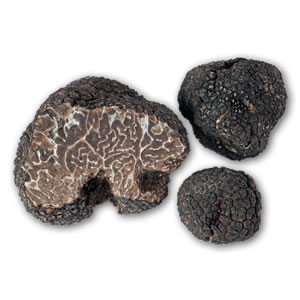Brumale truffle
The Brumale truffle (Tuber brumale Vitt.) is also known as the black winter truffle and is primarily harvested from November to mid-March. It has a very dark, almost black skin and is characterised by small flat and globular warts. It can vary in diameter from 2 to 9 centimetres and has pale, marbled flesh with a tangle of clear-cut veins in two main colours: white and grey.
Expert truffle hunters know that the ideal habitats of the Brumale truffle are large deciduous woods or areas that are particularly rich in oak trees, from which the truffle draws nourishment and acquires its superb aroma and colour. It is usually found between 5 and 30 cm below the surface, meaning that it is harvested using specialist truffle-hunting dogs, who sniff out its strong and unmistakable scent. It favours very chalky terrain, but it can also be found in other types of soil and at lower altitudes than those needed for large-scale forest growth.
Although it is much more economical than the prized black truffle, it is still an excellent addition to pasta and rice dishes and to main courses, enhancing them with its characteristic flavour (it is also known as the strong black truffle because of its persistent taste and lingering aroma, reminiscent of turnip in some specimens). It is particularly popular with those who love strong and decisive flavours. This species also includes the musky truffle (Tuber brumale var. moschatum De Ferry), which can be recognised by its persistent musky and woody aroma. This variety is mainly eaten raw in salads, to which it adds a piquant touch.

